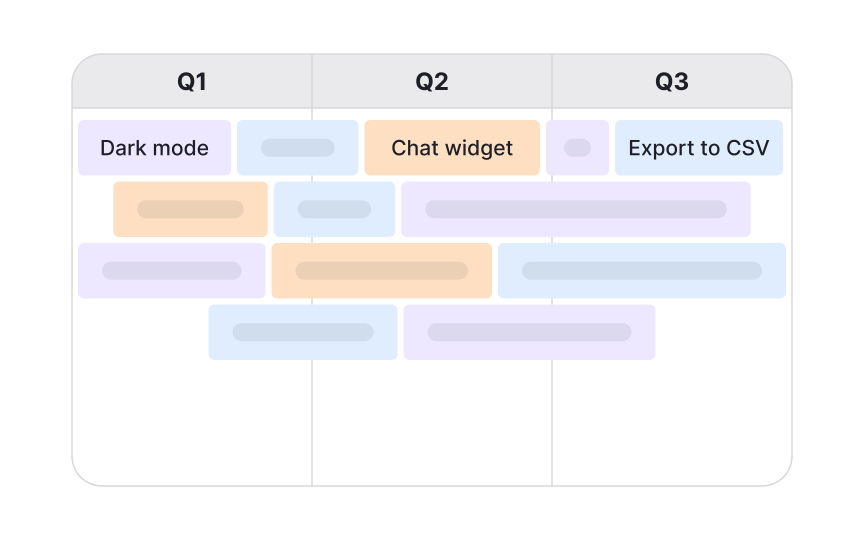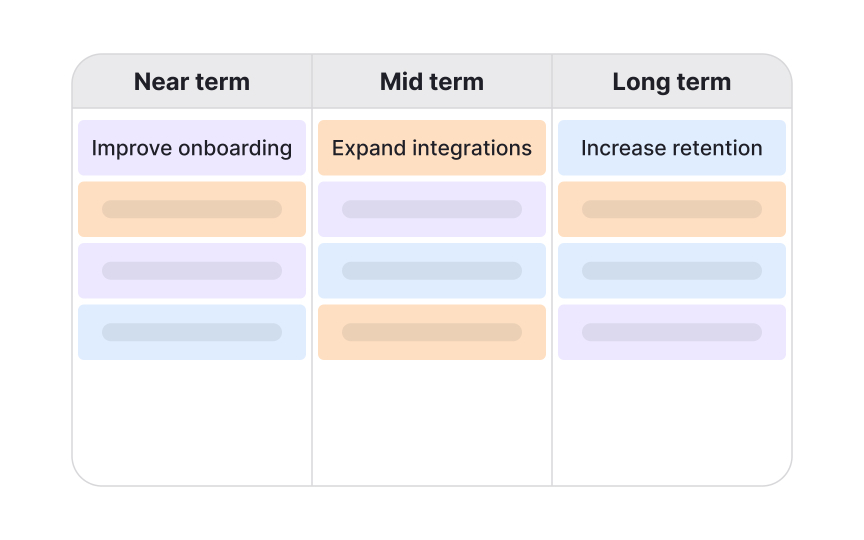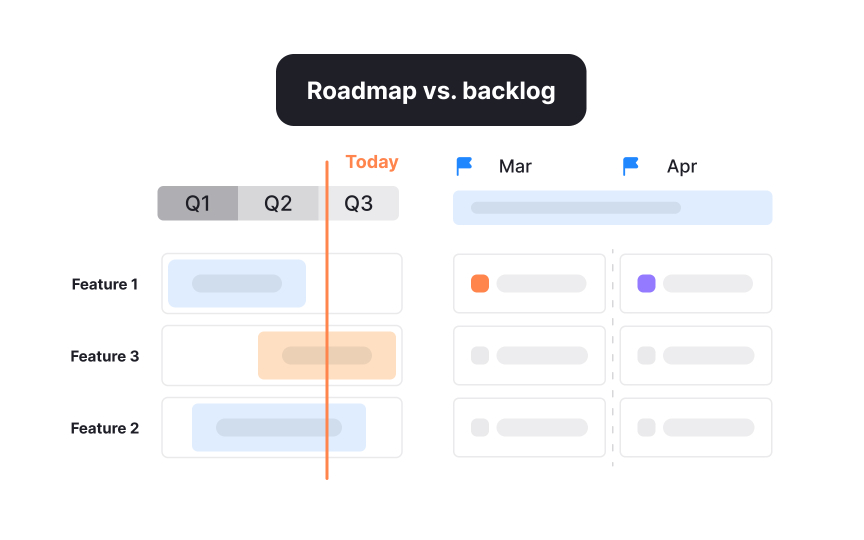Why You Need a Roadmap
Recognize why roadmaps succeed or fail and how to avoid common traps in product planning.
A product roadmap is more than a schedule of features. It is a communication tool that aligns teams, clarifies strategy, and connects daily work to long-term goals. Yet, many roadmaps fail because they create an illusion of certainty, focus on outputs instead of outcomes, or quickly become outdated. These flaws lead to wasted effort, misaligned expectations, and missed opportunities.
Understanding the difference between useful and harmful roadmaps is essential for effective product management. By questioning assumptions, examining pitfalls, and reframing roadmaps as strategic guides rather than rigid plans, product teams can stay responsive to change without losing direction. Strong roadmaps highlight problems to solve and value to deliver, rather than a checklist of features.
This lesson unpacks the common mistakes teams make when building roadmaps and contrasts them with practices that create clarity and trust. It invites learners to think critically about what a roadmap represents, how it should be used, and why treating it as a living document improves both collaboration and outcomes.
A
Its main role is to align diverse teams and stakeholders by offering a shared understanding of goals. Instead of promising exact delivery dates, it provides context for how current efforts link to long-term strategy. Roadmaps are living documents that shift with new insights, market changes, and evolving company priorities.[1]
When roadmaps are used this way, they foster collaboration and prevent misaligned expectations. They serve as compasses that point toward a common destination, while allowing flexibility in how that destination is reached.[2]
Many roadmaps lose effectiveness because they focus heavily on outputs such as features, dates, and releases. This narrow view encourages teams to deliver more items quickly, but it often results in features that do not improve user experience or meet business goals. The roadmap becomes a delivery list rather than a tool for solving problems.
An outcome-driven approach emphasizes value. Instead of asking what to build, it asks what problem should be solved and what result should be achieved. This can mean prioritizing fewer features, but ones tied to user satisfaction, retention, or measurable business growth.
The difference between output and outcome is not trivial. Roadmaps centered on outcomes avoid wasted effort and communicate impact in terms that both customers and stakeholders understand. By shifting the focus, product managers can guide teams toward meaningful results rather than simply delivering volume.[3]
Pro Tip: Frame your roadmap in terms of outcomes. Ask, “What will change for users?” not just “What will we deliver?”
One of the biggest risks in roadmapping is presenting the plan as if the future were predictable. Teams often attach specific features to fixed dates, which creates an impression of certainty. Stakeholders may then assume these items are guaranteed, when in reality, product development is shaped by shifting markets, evolving customer needs, and technical surprises.
The problem is not the presence of detail, but how that detail is communicated. Internally, more specific information about features or milestones can be useful for coordination. The danger arises when such information is shared as firm commitments or treated as unchangeable. Once expectations are set, changing direction can damage trust.
A healthier approach is to use themes, horizons, or flexible objectives to show intent without promising exact outcomes too early. This balances the need for detail in internal planning with the need for adaptability when priorities shift. In this way, roadmaps remain credible tools for alignment without creating the false belief that the future is fully known.
Roadmaps often lose relevance quickly because they capture a snapshot in time rather than a continuously updated view. Once created, many teams fail to revisit them, leaving outdated assumptions and obsolete priorities in place. This leads to confusion and misalignment, as different groups work from plans that no longer reflect reality.
Treating the roadmap as static makes it harder to respond to new opportunities or risks. Markets evolve, technologies shift, and customer needs change, which means a roadmap built months ago may no longer serve its purpose. To stay useful, roadmaps must be maintained as living documents. Regular updates informed by feedback, data, and strategy reviews ensure they remain credible and actionable.
When a roadmap reflects the latest understanding, it becomes a trusted reference point for decision-making. Teams can then rely on it to communicate direction, track progress, and stay aligned on evolving goals.[4]
Pro Tip: Schedule recurring roadmap reviews. Frequent updates prevent it from becoming a stale artifact.
A common misunderstanding is to confuse a
A backlog, in contrast, is tactical. It contains specific items such as features, bug fixes, or technical improvements to be completed by the team. It changes frequently as work is done and new tasks appear. Unlike a roadmap, the backlog does not explain how these tasks connect to larger goals. Mixing the two can blur strategy with execution and confuse stakeholders. Clear separation ensures that the roadmap remains a tool for alignment, while the backlog serves as an operational queue for delivery.
Traditional roadmaps often resemble long lists of features promised to stakeholders. This feature-driven approach seems practical, but it can harm product success. It shifts focus to delivery volume rather than solving meaningful problems. Teams may end up building features that are rarely used or add unnecessary complexity. Once published, such lists also create fixed expectations, making it difficult to adapt when priorities change.
Experts argue that effective roadmaps should emphasize problems to solve, outcomes to achieve, or broad themes to pursue rather than locking into a fixed list of features. This approach creates space for discovery and allows teams to adapt as new insights emerge. Strong product organizations resist the pressure to satisfy stakeholders by filling the roadmap with feature requests. Instead, they highlight objectives such as improving
By framing the roadmap around goals instead of features, teams avoid building items that add little value or become irrelevant over time. This shift also changes how stakeholders interpret the roadmap. Rather than expecting a guaranteed delivery of features, they see it as a guide for achieving meaningful impact. The emphasis moves from promising outputs to ensuring that product efforts contribute to user satisfaction and measurable business results.
A roadmap becomes powerful when it is used as a communication tool rather than just a planning file. Its role is to create a shared understanding across groups that often speak different languages. Executives want to see how product initiatives connect to strategic goals and business outcomes. Engineers need clarity on the order of work and technical dependencies. Sales and marketing look for signals that help them prepare campaigns and frame upcoming value in conversations with customers. Customer success teams rely on roadmaps to manage expectations and answer questions about the future direction of the product.
Because these groups focus on different needs, one version of the roadmap rarely fits all. Executives benefit from high-level themes, while engineering teams require more detailed milestones. Customers should only see simplified versions that highlight benefits without committing to exact dates or feature lists. When a single roadmap is shown to every audience, it often creates confusion or unrealistic expectations.
To avoid this, a roadmap should tell a story. Instead of presenting a list of features, it should explain which problems the team is addressing and what results those efforts are expected to bring. This approach gives context and helps stakeholders see how their work or interests connect to the bigger picture. By tailoring the roadmap and keeping it updated, product managers strengthen alignment and trust across the organization.
Roadmaps serve different purposes depending on who sees them. Internal roadmaps guide teams inside the company. They show priorities, dependencies, and goals in enough detail for engineers, designers, and executives to align their work and strategy.
External roadmaps are for customers, prospects, or partners. These versions should be simple and focus on value rather than delivery details. Instead of promising exact features or dates, they highlight benefits such as improved
Confusing the two creates problems. Sharing an internal roadmap externally can lock the company into commitments it cannot keep, while showing only a marketing-style version internally leaves teams without needed clarity. Clear separation ensures that each audience receives the right level of information while staying aligned on the same strategy.
References
- Product Management 101: Roadmapping - Pendo Blog | Pendo Blog
- The Ultimate Guide to Product Roadmaps | ProductPlan
- The Problem With Product Roadmaps | Medium
Topics
From Course
Share
Similar lessons

Roadmaps and Prioritization

Planning Roadmaps and Backlogs




















